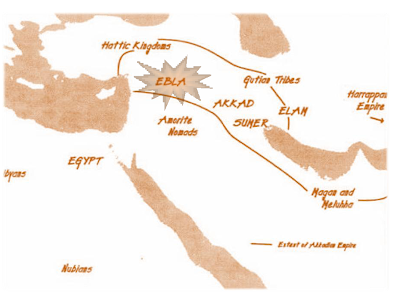These armies represent the forces to the north west of Mesopotamia in modern day Syria, principally the cities of Ebla and Mari, though many other city-states existed very much like those in Sumer. Ebla was a powerful and well established city-state in the third millennium. It had rich lands and was a major commercial centre, a rivalry shared with Mari with whom it often fought. Rich in textiles and timber Ebla is well known in Sumerian texts from an early time.
Such was the closeness between Sumeria and Ebla that they shared many common features of each other’s society, including for the most part the armaments and methods of war. At its peak Ebla ruled over two dozen or so large cities and received large tribute sums making it an enormously wealthy and powerful hegemonic city-state. This almost feudal arrangement meant an Eblan army at full strength would likely be made up of a number of contingents from other cities.
Mari, as Ebla’s chief rival, had influences from both Sumer and the Amorites. Its proximity to Sumer led to clashes with the Sumerian city-state of Lagash under its expansionist warrior king Eannatum. Mari however mostly looked west. It vied for control of the lesser city states lying between itself and Ebla in order to extract tribute and wealth from these settlements on the upper Euphrates, just as Ebla had. This fierce rivalry between the two cities resulted in numerous clashes over a period of a century, much as the Sumerian city-states of Umma and Lagash did. Early on (c. 2400 BC) Mari took control of Ebla, but Ebla threw off Mariote control and once again established its own rule.
Toward the end of these wars the scale of operations was such that in Ebla’s final campaign against Mari in 2340 BC reports of 3,600 dead at a battle at Darashum and another 3,200 dead at Badanu and Masanu indicate just how large and/or fiercely fought these battles must have been. Nevertheless, just like Umma and Lagash, it was the Akkadian Sargon who made war on Ebla (and Mari) absorbing them into his empire, not long after the Eblaite general Enna-Dagan captured Mari in the aforementioned campaign of 2340 BC.
After Sargon’s death and being distant from Akkadian influence, Sargon’s successors became occupied with troubles in the south of their empire allowing Ebla (and Mari) to reassert a degree of independence. Once again they made war on each other and also suffered incursions from Hattian Kingdom barbarians around 2200 BC. Upon the succession of Naram Sin however he reconquered and destroyed Ebla ending its third millennium golden age.
Not long after his death the Akkadian Empire fell to the Gutian invasion and Ebla rebuilt. Whilst never as strong as it once was, it tried to reassert its independence once again. With the rise of the Neo-Sumerian Third Dynasty of Ur, for whom it remained a reliable ally, the city eventually fell to the dynasty of generals and finally the sack of the Amorites who made the city their own.
Troop Type
|
Number
|
Q
|
P
|
CV
|
Range
|
Pts
|
General (mounted)
|
1
|
-
|
*
|
5
|
n/a
|
50
|
Sub General (mounted)
|
0-2
|
-
|
*
|
5
|
n/a
|
50
|
Eblan Ally General (mounted)
|
0-1
|
-
|
*
|
25
|
n/a
|
25
|
Captain
|
1
per unit
|
R
|
*
|
5
|
n/a
|
20
|
- change to
veteran/levy
|
any
|
V/L
|
*
|
5
|
25/15
|
|
4-Ass Battle Carts
|
2-5
|
V
|
S
|
special
|
4
|
35
|
- exchange for
4-Ass Straddle Car / Platform Cart
|
0-1
|
V
|
U/P
|
special
|
4
|
20/25
|
Bodyguard
Spearmen
|
0-1
|
V
|
P
|
4
|
n/a
|
16
|
- equip as
Axemen
|
0/all
|
V
|
P
|
5
|
n/a
|
18
|
Militia
Spearmen
|
2-8
|
L
|
P
|
3
|
n/a
|
4
|
- upgrade to
Regulars as Household
|
0-4
|
R
|
P
|
3
|
n/a
|
7
|
- upgrade to
Shielded front rankers (regular/levy)
|
0-half
|
R/L
|
S
|
3
|
n/a
|
8/5
|
Settled
or Nomadic Archers
|
1-4
|
L
|
U
|
n/a
|
4
|
2
|
- upgrade to
Regular
|
0-2
|
R
|
U
|
n/a
|
4
|
4
|
- change to
Massed Archers
|
0-2
|
L/R
|
U
|
2
|
4/8
|
3/6
|
Settled
or Nomadic Skirmishers
|
1-3
|
L
|
U
|
n/a
|
4
|
2
|
Settled
or Nomadic Slingers
|
0-2
|
L
|
U
|
2
|
4
|
2
|
Iranian
Wild Tribesmen
|
0-1
|
R
|
U
|
special
|
2/4
|
6
|
- equip with
shields; or
|
half
|
R
|
P
|
special
|
2/4
|
7
|
- change to
Massed Archers
|
0/all
|
R
|
U
|
2
|
4/8
|
6
|
Hattian
Spearmen
|
0-1
|
R
|
P
|
3
|
n/a
|
5
|
Early Eblan Allies and Enemies
Dynastic Sumerian
|
Akkadian
|
Early Eblan
|
Old Elam
|
Zagros Mountain
|
Hattian Kingdoms
|
Neo-Sumerian
|
Amorite Nomads
|
Magan
|
Harrapan
|
|||||||||||||||||||||||||||||||
2700 BC
|
||||||||||||||||||||||||||||||||||||||||
2600
BC
|
||||||||||||||||||||||||||||||||||||||||
2500
BC
|
||||||||||||||||||||||||||||||||||||||||
2400
BC
|
||||||||||||||||||||||||||||||||||||||||
2300
BC
|
||||||||||||||||||||||||||||||||||||||||
2200
BC
|
||||||||||||||||||||||||||||||||||||||||
2100
BC
|
||||||||||||||||||||||||||||||||||||||||
2000
BC
|
||||||||||||||||||||||||||||||||||||||||
Special Rules & Notes
- Eblan ally generals must command a force made up of at least one Battle Cart, one Spearmen and one Skirmisher unit.

No comments:
Post a Comment